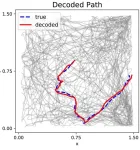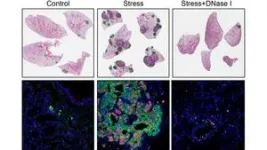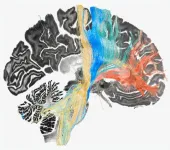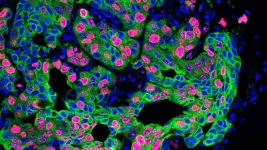(Press-News.org) Researchers have paired a deep learning model with experimental data to “decode” mouse neural activity. Using the method, they can accurately determine where a mouse is located within an open environment and which direction it is facing just by looking at its neural firing patterns. Being able to decode neural activity could provide insight into the function and behavior of individual neurons or even entire brain regions. These findings, publishing February 22 in Biophysical Journal, could also inform the design of intelligent machines that currently struggle to navigate autonomously.
In collaboration with researchers at the US Army Research Laboratory, senior author Vasileios Maroulas’ team used a deep learning model to investigate two types of neurons that are involved in navigation: “head direction” neurons, which encode information about which direction the animal is facing, and “grid cells,” which encode two-dimensional information about the animal’s location within its spatial environment.
“Current intelligence systems have proved to be excellent at pattern recognition, but when it comes to navigation, these same so-called intelligence systems don’t perform very well without GPS coordinates or something else to guide the process,” says Maroulas (@VMaroulas), a mathematician at the University of Tennessee Knoxville. “I think the next step forward for artificial intelligence systems is to integrate biological information with existing machine-learning methods.”
Unlike previous studies that have tried to understand grid cell behavior, the team based their method on experimental rather than simulated data. The data, which were collected as part of a previous study, consisted of neural firing patterns that were collected via internal probes, paired with “ground-truthing” video footage about the mouse’s actual location, head position, and movements as they explored an open environment. The analysis involved integrating activity patterns across groups of head direction and grid cells.
“Understanding and representing these neural structures requires mathematical models that describe higher-order connectivity—meaning, I don’t want to understand how one neuron activates another neuron, but rather, I want to understand how groups and teams of neurons behave,” says Maroulas.
Using the new method, the researchers were able to predict mouse location and head direction with greater accuracy than previously described methods. Next, they plan to incorporate information from other types of neurons that are involved in navigation and to analyze more complex patterns.
Ultimately, the researchers hope their method will help design intelligent machines that can navigate in unfamiliar environments without using GPS or satellite information. “The end goal is to harness this information to develop a machine-learning architecture that would be able to successfully navigate unknown terrain autonomously and without GPS or satellite guidance,” says Maroulas.
###
This research was supported by the US Army Research Lab.
Biophysical Journal, Mitchell et al., “A Topological Deep Learning Framework for Neural Spike Decoding” https://www.cell.com/biophysical-journal/fulltext/S0006-3495(24)00041-9
Biophysical Journal (@BiophysJ), published by Cell Press for the Biophysical Society, is a bimonthly journal that publishes original research and reviews on the most important developments in modern biophysics—a broad and rapidly advancing field encompassing the study of biological structures and focusing on mechanisms at the molecular, cellular, and systems levels through the concepts and methods of physics, chemistry, mathematics, engineering, and computational science. Visit http://www.cell.com/biophysj/home. To receive Cell Press media alerts, contact press@cell.com.
END
A large language model (LLM) artificial intelligence (AI) system can match, or in some cases outperform, human ophthalmologists in the diagnosis and treatment of patients with glaucoma and retina disease, according to research from New York Eye and Ear Infirmary of Mount Sinai (NYEE).
The provocative study, published February 22, in JAMA Ophthalmology, suggests that advanced AI tools, which are trained on vast amounts of data, text, and images, could play an important role in providing decision-making support to ophthalmologists in the diagnosis and management of cases involving glaucoma and retina ...
"Trans masculine people are people born female but do not identify as such, for example they feel male, gender fluid or non-binary. Our examination of their ovarian tissue shows that 33% of them show signs of recent ovulation, despite being on testosterone and no longer menstruating," says Joyce Asseler, PhD candidate at Amsterdam UMC.
Trans masculine people often use hormone treatment with testosterone to masculinize physically. This hormone usually stops them from menstruating. In that ...
A new study led by investigators from Mass General Brigham demonstrated the use of deep brain stimulation (DBS) to map a ‘human dysfunctome’ — a collection of dysfunctional brain circuits associated with different disorders. The team identified optimal networks to target in the frontal cortex that could be used for treating Parkinson’s disease, dystonia, obsessive compulsive disorder (OCD) and Tourette's syndrome. Their results are published in Nature Neuroscience.
“We were able to use brain stimulation to precisely identify and target circuits for the optimal treatment of four different ...
About The Study: This study found that all-sites cancer incidence in the U.S. was significantly lower than expected in March through December 2020, with 134,395 potentially undiagnosed cancer cases. The overall and differential findings can be used to inform where the health care system should be looking to make up ground in cancer screening and detection.
Authors: Krystle A. Lang Kuhs, Ph.D., M.P.H., of the University of Kentucky in Lexington, is the corresponding author.
To access the embargoed study: Visit our For The Media website at this link https://media.jamanetwork.com/
(doi:10.1001/jamaoncol.2023.6969)
Editor’s ...
About The Study: The results of this study suggest a high burden of refractive error–associated correctable refractive error in African American adults, making it the leading cause of visual impairment in this population. Providing universal coverage for vision care and prescription glasses is an affordable and achievable health care intervention that could reduce the burden of visual impairment in African American adults by over two-thirds and likely raise the quality of life and work productivity, ...
About The Study: Vision impairment was associated with several psychosocial outcomes, including symptoms of depression and anxiety and social isolation in this study including 2,822 U.S. adults age 65 and older. These findings provide evidence to support prioritizing research aimed at enhancing the health and inclusion of people with vision impairment.
Authors: Pradeep Y. Ramulu, M.D., M.H.S., Ph.D., of the Johns Hopkins University School of Medicine in Baltimore, is the corresponding author.
To access the embargoed ...
Stress is inevitable. But too much of it can be terrible for our health. Chronic stress can increase our risk for heart disease and strokes. It may also help cancer spread. How this works has remained a mystery—a challenge for cancer care.
Xue-Yan He, a former postdoc in Cold Spring Harbor Laboratory (CSHL) Adjunct Professor Mikala Egeblad’s lab, says, “Stress is something we cannot really avoid in cancer patients. You can imagine if you are diagnosed, you cannot stop thinking about the disease or insurance ...
Over 134,000 cancer cases went undiagnosed in the U.S. during the first 10 months of the COVID-19 pandemic, according to a new University of Kentucky Markey Cancer Center study.
The report published in JAMA Oncology Feb. 22 provides the first estimates of missed cancer diagnoses in 2020 using nationwide surveillance data.
Researchers have expected impacts to cancer detection as a result of delayed screenings and missed health care appointments due to the COVID-19 pandemic, but the extent of this impact had not been quantified until ...
New research at the Roy Blunt NextGen Precision Health building has discovered a potential treatment for an underlying cause of cardiovascular disease in people with Type 2 diabetes.
More than 30 million Americans live with Type 2 diabetes. One common feature of diabetes is the hardening and inflexibility of blood vessels caused by damage to the endothelial cells in the vascular system. Over time, this can lead to the development and progression of cardiovascular disease, which is the number one cause of death in diabetics. Because endothelial dysfunction is causally linked to cardiovascular disease, there is a considerable ...
FOR IMMEDIATE RELEASE
Drugs that target a receptor on immune cells called activin receptor 1C may combat tumor-induced immune suppression and help patients’ immune systems fight back against cancer, according to a study by investigators at the Johns Hopkins Kimmel Cancer Center and its Bloomberg~Kimmel Institute for Cancer Immunotherapy.
The study, published online Jan. 8 in Oncoimmunology, identifies a new strategy cancer cells use to protect themselves from immune system attack, and suggests treatments that could counteract it. It shows that tumor cells and some immune cells produce proteins called activins that ...



